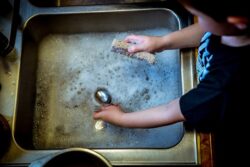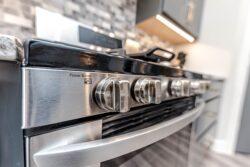
In the heart of every bustling commercial kitchen, the hood silently performs a crucial task – keeping the air clean and safe. Yet, behind the scenes, a layer of grease accumulates on the hood and its components, creating a potential fire hazard. This comprehensive guide unravels the essential aspects of commercial kitchen hood cleaning, shedding light on the vital role it plays in fire prevention and overall kitchen safety. From understanding the fire risks posed by grease buildup to exploring the methods of effective cleaning, this article equips restaurant owners, kitchen managers, and cleaning professionals with the knowledge needed to maintain a secure and thriving kitchen environment.
Commercial kitchens are dynamic spaces where the sizzle of pans and the clatter of dishes create an energetic symphony. Amidst this culinary orchestra, the kitchen hood silently safeguards against the unseen threat of grease buildup. However, the accumulation of grease over time not only affects the efficiency of the hood but also poses a significant fire risk. This guide aims to demystify the complexities of commercial kitchen hood cleaning, emphasizing its role as a paramount measure in fire prevention and ensuring the safety of kitchen operations. As we delve into the details, readers will gain a comprehensive understanding of why regular cleaning is not just a chore but a strategic investment in the longevity and security of commercial kitchens.
See also our post on Going Green in the Kitchen: Sustainable Cleaning for Appliances
Understanding the Fire Risks
Combustibility of Grease
Grease, a natural byproduct of cooking, is highly combustible. When allowed to accumulate, it becomes a fuel source for fires, posing a severe risk in commercial kitchens.
Flash Point
The flash point, or the temperature at which grease ignites, is relatively low. Accumulated grease on hoods, ducts, and fans can reach this critical temperature, leading to sudden and intense fires.
Rapid Fire Spread
Once ignited, grease fires can spread rapidly. The hood, ductwork, and other kitchen components can act as conduits, allowing flames to swiftly travel through the entire ventilation system.
Increased Severity of Fires
Fires fueled by grease tend to burn at higher temperatures and with greater intensity. This escalation poses not only a threat to kitchen staff but also increases the likelihood of significant property damage.
Regulatory Compliance
Maintaining a clean kitchen hood is often a legal requirement. Non-compliance with fire safety regulations can result in penalties and, more importantly, compromise the safety of the kitchen and its occupants.
Importance of Regular Hood Cleaning
Fire Prevention
Regular hood cleaning is a proactive measure to prevent grease fires. Removing accumulated grease ensures that there is no fuel source available to ignite and sustain a fire.
Enhanced Air Quality
A clean kitchen hood improves air quality by effectively capturing and venting cooking-related pollutants. This contributes to a healthier and more comfortable environment for kitchen staff.
Efficiency of Ventilation System
Accumulated grease can obstruct the ventilation system, reducing its efficiency. Regular cleaning ensures that the hood functions optimally, maintaining proper airflow and ventilation.
Compliance with Insurance Requirements
Insurance providers often mandate regular hood cleaning as a condition for coverage. Failure to adhere to these requirements can result in increased insurance premiums or even denial of coverage in case of fire-related incidents.
Prolonged Equipment Lifespan
Routine cleaning of the kitchen hood and its components contributes to the prolonged lifespan of the equipment. This, in turn, reduces maintenance costs and the need for premature replacements.
Signs that Cleaning is Required
Visible Grease Buildup
Inspect the hood regularly for visible grease buildup. Greasy residues on the hood’s surfaces, as well as on nearby walls and ceiling, are indicative of the need for cleaning.
Unusual Odors
Persistent and unpleasant odors in the kitchen may signal the presence of accumulated grease in the hood. Cleaning helps eliminate these odors and ensures a fresh kitchen environment.
Reduced Airflow
A noticeable reduction in the airflow from the hood indicates potential blockages caused by grease buildup. Restoring proper airflow is crucial for the effectiveness of the ventilation system.
Sputtering or Fluctuating Flames
Gas stoves exhibiting sputtering or fluctuating flames can be a sign of grease accumulation in the hood. Cleaning addresses this issue and ensures consistent and safe stove operation.
Increased Noise Levels
Excessive noise from the ventilation system may indicate the presence of obstructions caused by grease. Regular cleaning helps maintain smooth and quiet system operation.
See also our post on How to Clean and Maintain Your Kitchen Pantry: A Foodie’s Dream
Methods of Hood Cleaning
Manual Scrubbing
Hand scrubbing involves physically cleaning surfaces with grease-cutting cleaning agents. This method is effective for removing visible grease and grime.
Steam Cleaning
Steam cleaning utilizes high-temperature steam to dissolve and loosen grease. It is effective for deep cleaning and sanitizing, particularly in hard-to-reach areas.
Pressure Washing
Pressure washing employs pressurized water to dislodge and remove stubborn grease deposits. It is suitable for cleaning hoods, ducts, and exhaust fans.
Chemical Cleaning Agents
Specialized cleaning agents designed to break down and emulsify grease are used in conjunction with other cleaning methods. These chemicals enhance the effectiveness of the cleaning process.
Professional Cleaning Services
Engaging professional hood cleaning services ensures a thorough and comprehensive cleaning process. Professionals have the expertise, equipment, and knowledge to address all components of the ventilation system.
Frequency of Hood Cleaning
Regular Schedule
Establish a regular cleaning schedule based on the volume of cooking and kitchen operations. High-traffic kitchens may require more frequent cleaning to prevent grease buildup.
Compliance with Standards
Adhere to industry standards and guidelines for hood cleaning frequency. These standards take into account the type of cooking equipment, volume of cooking, and the specific needs of the kitchen.
Post-Heavy Usage Cleaning
After periods of heavy usage, such as holidays or special events, conduct additional cleaning to address increased grease accumulation. This proactive approach prevents potential fire hazards.
Inspection-based Cleaning
Implement an inspection-based cleaning approach, where cleaning frequency is adjusted based on visual inspections and signs of grease buildup. This ensures that cleaning is performed as needed.
Record-keeping
Maintain detailed records of hood cleaning activities, including dates, methods used, and any issues identified. This documentation serves as a reference for compliance and future cleaning requirements.
Safety Measures During Cleaning
Shutdown of Cooking Equipment
Before initiating hood cleaning, ensure that all cooking equipment is turned off. This eliminates the risk of accidental fires during the cleaning process.
Protection of Kitchen Surfaces
Cover and protect kitchen surfaces, appliances, and equipment to prevent cleaning agents and water from causing damage. This also facilitates easier cleanup after the hood cleaning is complete.
Personal Protective Equipment (PPE)
Cleaning personnel should wear appropriate PPE, including gloves and eye protection. This safeguards against exposure to cleaning agents and ensures the safety of those performing the cleaning.
Adequate Ventilation
Ensure proper ventilation during the cleaning process. This involves turning on exhaust fans and opening windows to disperse fumes and prevent the buildup of cleaning-related vapors.
Fire Extinguisher Availability
Have a working fire extinguisher readily available during hood cleaning. This is a precautionary measure in case of any unexpected ignition during the cleaning process.
Post-Cleaning Inspection and Maintenance
Thorough Inspection
After cleaning, conduct a thorough inspection of the hood, ducts, and exhaust fans. Ensure that all visible grease and grime have been effectively removed, and no obstructions remain.
Verification of Proper Functionality
Verify the proper functionality of the ventilation system post-cleaning. This includes checking airflow, fan operation, and the absence of any unusual noises.
Addressing Repairs and Replacements
Identify and address any repairs or replacements needed for the hood and its components. This proactive approach ensures that the ventilation system remains in optimal condition.
Reassessment of Cleaning Frequency
Based on post-cleaning observations and the condition of the kitchen, reassess the frequency of future hood cleaning. Adjust cleaning schedules as needed to maintain a safe and clean environment.
Continuous Monitoring
Implement continuous monitoring of the kitchen hood and ventilation system. Regular visual inspections and adherence to a maintenance schedule contribute to ongoing fire prevention and safety.
See also our post on Restaurant Kitchen Cleaning: Maintaining Hygiene Standards
Conclusion
In conclusion, commercial kitchen hood cleaning is not just a routine task; it’s a fundamental practice for ensuring fire prevention and overall safety. From understanding the fire risks associated with grease buildup to exploring effective cleaning methods and safety measures, this guide serves as a comprehensive resource for kitchen managers and cleaning professionals. By recognizing the critical role of hood cleaning in preserving the security and functionality of commercial kitchens, we embark on a journey toward safer, more resilient kitchen environments. As the flames dance in the kitchen, let us ensure that they remain a symbol of culinary passion, not a threat to the safety of our kitchens and those who work within them.







